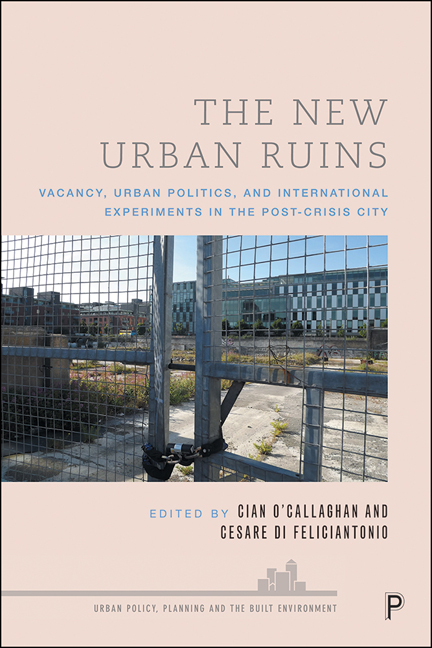Book contents
- Frontmatter
- Contents
- List of figures and tables
- Notes on contributors
- Acknowledgements
- Introduction
- PART I Rethinking ruination in the post-crisis context
- PART II The political economy of urban vacant space
- PART III Reappropriating urban vacant spaces
- Conclusion: Centring vacancy – towards a research agenda
- Index
5 - Nullius no more? Valorising vacancy through urban agriculture in the settler-colonial ‘green city’
Published online by Cambridge University Press: 13 May 2022
- Frontmatter
- Contents
- List of figures and tables
- Notes on contributors
- Acknowledgements
- Introduction
- PART I Rethinking ruination in the post-crisis context
- PART II The political economy of urban vacant space
- PART III Reappropriating urban vacant spaces
- Conclusion: Centring vacancy – towards a research agenda
- Index
Summary
Introduction
Among the brick warehouses and new-build condos of Montreal's hip Mile-Ex neighbourhood, a group of musicians leads a parade a few dozen strong. The intergenerational crowd comes to a stop and circles together in a gravel-covered vacant lot, chattering happily and bouncing in time to the bass drum and snare, while the band's clarinets, accordion, cello and tuba crank out a lively tune. A mother flanked by her two young children scrapes away some of the gravel and begins digging holes in the clay beneath. Another woman places a basil plant in one of the holes and pats some soil back around its base. Someone else empties a basketful of ‘seed bombs’ on the ground and calls out for people to come and grab some. A young girl picks up one of the small balls of clay packed with herb and wildflower seeds, walks a few feet, cranks her arm back, and hurls it as if it were a Molotov cocktail, the first of many thrown in this battle, in the words of the event's organisers, to approprier la ville (‘reclaim the city’).
In Montreal, as in cities across North America, it is often not long before some group or other replaces the gravel, asphalt or weeds of a vacant lot with something more verdant: beds of rich soil and compost giving life to leafy vegetables, vines, fruits and flowers. Indeed, the relationship between vacancy and urban agriculture is arguably as old as urban food production itself; city dwellers have always opportunistically gardened or grazed animals on the grass and weeds growing in the ‘wastelands’, those interstitial spaces between and within residential and commercial lots, markets, streets and sidewalks (Vitiello and Brinkley, 2014). They do so for a variety of reasons, from a desire to improve access to fresh and healthy produce, to community building, to recreation and mental health, employing ‘motivational frames’ that may be entrepreneurial or anti-capitalist, political or apolitical, and individual or collective (McClintock and Simpson, 2018). Like the Montrealers described earlier, many cultivate vacant lots as a means to ‘reclaim the commons’ or to assert their ‘right to the city’ (Staeheli et al, 2002; Purcell and Tyman, 2015; Eidelman and Safransky, 2020), in the process, transgressing formal or juridical forms of property, and blurring the boundary between public and private (Blomley, 2004).
- Type
- Chapter
- Information
- The New Urban RuinsVacancy, Urban Politics, and International Experiments in the Post-Crisis City, pp. 91 - 108Publisher: Bristol University PressPrint publication year: 2021



